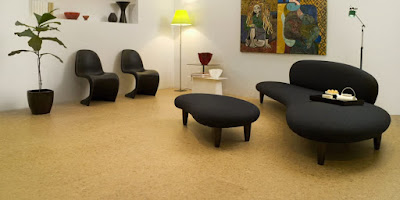Cork is a
natural material which is best known for its renewability. It's generally
harvested from the bark of cork oak trees that are native to Portugal, Tunisia,
and Spain and has been utilized as a preferred construction material for
centuries. It has grown its popularity in other counters as a flooring material
because of its beauty, ‘green’ qualities, and durability and other special and
unique characteristics.
Healthy:
Since cork is a natural material which isn’t manufactured in factories, it is
greatly resistant to mildew, mold, and termites, additionally, It is anti-microbial
also. Cork flooring doesn’t off-gas or shed microfibers hence your indoor air
quality would not get affected.
Durability:
It greatly prevents abrasions and cracking and is impermeable to liquid and
gas. Indentations caused by heavy furniture wouldn’t be permanent since cork
flooring bounces back. Cork flooring
can stay at its best and last for 40 years or more if maintained with proper
care.
Safe: It is
one of the best fire-resistant materials. Prior to and during combustion, cork creates
less smoke and releases very less toxic gases than vinyl. However, it has to be
extremely high temperature to make the cork ignite, burn, or melt.
Comfort
Matters: The cork floor provides a
comfortable cushion-like feeling underfoot as it gets compressed. Additionally,
it is an acoustic insulator and natural thermal which would provide a warm and
quiet atmosphere inside the house.
Versatility:
Cork flooring is available in a wide range of styles, sizes, and colors, moreover,
as a flooring material it is available in tiles and planks. One can use planks
to create a simple yet seamless-looking floor or use tiles in single or
alternating colors in order to create a trendy effect.
As a
building material, cork has a minimal negative effect on the environment. The
practice of harvesting is sustainable for a single thing which is that a tree
must be no less than 25 years of age before its bark can be collected; from
that point forward; cork can be harvested every eight to 14 years without
cutting the tree. Cork trees could live for 800 years; however today their
average lifespan is 180 to 200 years.
Additional
Characteristics: The production process of cork
flooring creates no waste. Truth be told, cork flooring is really a result
of the assembling of cork stoppers that are used in wine bottles. The residuals
from the stopper manufacturing are gathered and ground perfectly. Then, to hold
the ground and plug together, binders are utilized. Binders regularly
incorporate phenol formaldehyde, urea melamine, and normal proteins, which are
moderately steady once prepared. Shade is added to make distinctive designs and
colors, and at last a finish is applied.
Cork
flooring basically comes in two major types of finishes: water-based finish and
polyurethane/acrylic-based. Water-based finishes are environmentally friendly
and also less likely to get faded with exposure to light. Polyurethane/acrylic
finishes are a little tougher and, thus, would greatly protect the flooring in
a better way.

No comments:
Post a Comment